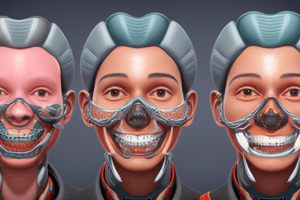Podcast
Questions and Answers
What is the primary goal of orthodontics?
What is the primary goal of orthodontics?
- To perform dental surgeries
- To replace missing teeth
- To provide routine dental cleanings
- To improve oral function and aesthetics (correct)
Which of the following conditions is characterized by the upper teeth significantly overlapping the lower teeth?
Which of the following conditions is characterized by the upper teeth significantly overlapping the lower teeth?
- Overbite (correct)
- Open bite
- Crossbite
- Underbite
Which type of orthodontic appliance is known for being placed on the back of the teeth to remain hidden from view?
Which type of orthodontic appliance is known for being placed on the back of the teeth to remain hidden from view?
- Metal braces
- Ceramic braces
- Lingual braces (correct)
- Clear aligners
What is a common treatment duration for orthodontic procedures?
What is a common treatment duration for orthodontic procedures?
Which emerging technology is used in orthodontics for customizing patient care?
Which emerging technology is used in orthodontics for customizing patient care?
Flashcards are hidden until you start studying
Study Notes
Orthodontics
-
Definition
- A branch of dentistry that deals with diagnosing, preventing, and correcting misaligned teeth and jaws.
-
Goals
- Improve oral function (bite and chewing).
- Enhance aesthetic appearance of the smile.
- Promote oral health by making teeth easier to clean and maintain.
-
Common Conditions Treated
- Crowding: Insufficient space for teeth, leading to overlapping.
- Spacing: Gaps between teeth due to missing teeth or excess space.
- Overbite: Upper teeth significantly overlap lower teeth.
- Underbite: Lower teeth project beyond upper teeth.
- Crossbite: Misalignment where upper teeth fit inside lower teeth.
- Open bite: Lack of vertical overlap between front teeth.
-
Types of Orthodontic Appliances
- Braces:
- Metal Braces: Traditional; consist of brackets and wires.
- Ceramic Braces: Tooth-colored for aesthetic appeal.
- Lingual Braces: Placed on the back of teeth, hidden from view.
- Clear Aligners:
- Customized, removable aligners (e.g., Invisalign) for discreet treatment.
- Retainers:
- Used post-treatment to maintain teeth position.
- Braces:
-
Treatment Process
- Initial Consultation: Examination, diagnostic records (X-rays, impressions).
- Treatment Plan: Customized based on individual needs.
- Active Treatment: Regular adjustments and monitoring of braces or aligners.
- Retention Phase: Use of retainers to stabilize teeth in their new position.
-
Duration
- Treatment length varies (6 months to 3 years) depending on complexity.
-
Importance of Orthodontics
- Prevents oral health issues (tooth decay, gum disease).
- Improves speech and chewing function.
- Boosts self-esteem and confidence through improved aesthetics.
-
Emerging Technologies
- 3D imaging and printing for precise appliance fabrication.
- Digital treatment planning for customized patient care.
- Accelerated orthodontics techniques to shorten treatment time.
Orthodontics Overview
- Branch of dentistry focused on diagnosing, preventing, and correcting misaligned teeth and jaws.
Goals of Orthodontics
- Enhance oral function, particularly bite and chewing efficiency.
- Improve aesthetic appearance, leading to a more attractive smile.
- Foster oral health by simplifying cleaning and maintenance of teeth.
Common Conditions Treated
- Crowding: Insufficient space results in overlapping teeth.
- Spacing: Gaps present between teeth due to missing teeth or excess space.
- Overbite: Significant overlap of upper teeth over lower teeth.
- Underbite: Lower teeth project beyond upper teeth.
- Crossbite: Misalignment where upper teeth sit inside lower teeth, leading to uneven wear.
- Open bite: Absence of vertical overlap between the front teeth.
Types of Orthodontic Appliances
- Braces:
- Metal Braces: Traditional, consisting of brackets and wires for effective alignment.
- Ceramic Braces: Aesthetic option with tooth-colored brackets to blend with teeth.
- Lingual Braces: Hidden brackets placed on the back of teeth, making them less visible.
- Clear Aligners: Customized, removable aligners such as Invisalign for discreet correction.
- Retainers: Essential post-treatment to maintain the new position of teeth.
Treatment Process
- Initial Consultation: Includes comprehensive examination and diagnostic records like X-rays and impressions.
- Treatment Plan: Tailored plans developed according to individual needs.
- Active Treatment: Involves regular adjustments and close monitoring of braces or aligners.
- Retention Phase: Usage of retainers to secure teeth in their new positions after active treatment.
Treatment Duration
- Varied treatment length ranging from 6 months to 3 years based on the complexity of the case.
Importance of Orthodontics
- Prevents oral health issues such as tooth decay and gum disease.
- Enhances speech and chewing capabilities.
- Boosts self-esteem and confidence through improved smile aesthetics.
Emerging Technologies
- Utilization of 3D imaging and printing for tailored appliance manufacturing.
- Implementation of digital treatment planning for personalized patient management.
- Introduction of accelerated orthodontics techniques to reduce overall treatment time.
Studying That Suits You
Use AI to generate personalized quizzes and flashcards to suit your learning preferences.




